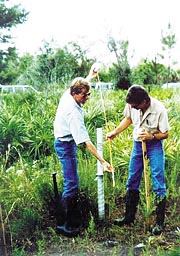The severe drought of the 1930s in much of the United States created widespread concern that declining water levels in wells and diminished flow of springs may be warnings of the eventual exhaustion of the nation's ground water supplies. During the drought years of the 1930s, considerable interest arose in the establishment of systematic programs for monitoring water levels in observation wells. It is instructive to compare the status of water level monitoring during the 1930s, during the 1950s (a second severe drought period) and today at the beginning of the 21st century.

The 1930s
In 1933, about 3,000 observation wells were being measured periodically by the United States Geological Survey (USGS) and by state agencies, and about 115 of these wells were equipped with automatic (continuous) water level recorders. Records of water levels covering many years were available for only a few areas, notably Southern California, Honolulu, the Roswell Basin in New Mexico and Long Island, N.Y. Other areas of heavy withdrawals had more sporadic water level records.
In 1936, the USGS released the first annual report on the fluctuations of ground water levels and artesian pressures in the United States. This report was envisioned "as a step in the realization of a nationwide program of water level records." At the time, it was noted that the availability of water level records was dependent upon ongoing investigations and that some of the most valuable records were in danger of being discontinued because of lack of funds for the projects that supported the monitoring. The need also was expressed for more observation wells outside of areas of major ground water withdrawals to provide information on the effects of climatic variations on water levels. In addition, increased automatic monitoring of water levels was recommended.
Report Abusive Comment